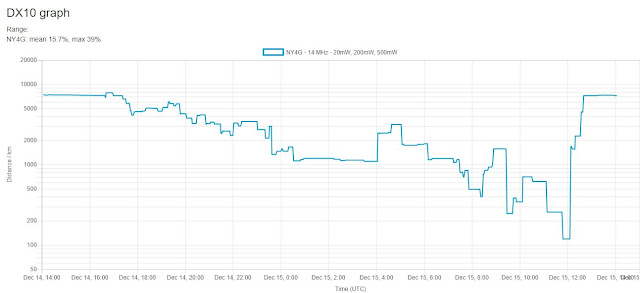Instead of using and setting up my shack rigs for WSPR, I have instead a dedicated WSPR transmitter from SOTABeams as can be seen in the picture below:
The setup is super light and consists of a WSPRlite classic box which uses 5V (USB) power and transmits at 200 mW. The other box on the left is a 5V signal conditioner with 12V input. This insures that the input from a switching power supply is clean (no ripples). Here I am using a 12V SLA battery which should be clean to begin with but still needs to be stepped down to 5V. This setup is light enough that it can be carried into the field, even on a SOTA expedition. Input can also be from a USB charging station, like those sold to recharge phones and tablets.
Objectives:
(1) Establish a standard - for 30m - a 30m dipole sloper, 40m - a 40 meter dipole inverted V, 20m - hexbeam at a certain fixed azimuth
(2) Compare that standard to my SOTA antennas - the EFHW Trail Friendly 40-20-10, the EF MTR - in their normal deployed position - typically inverted L or inverted V
Here is an image of the placement of the antenna on the property. So the broadside for maximum gain is approximately at 55 degrees azimuth from true north. There is a northwest null point with some omni gain in the direction of the slope down.
Here are the far field plots according to EZNEC
The model predictions maximum gain in the most preferred azimuth of 55 to be 7.26 dBi. Let's see if the model predictions hold up against the real world.
First results - Standard for 30m. The first image is a great circle map with receiving stations plotted. The second image is a table of distances as a function of UTC time. As can be expected, the night time distances are shorter - with a second peak near 0500 UTC that is not as far as the daytime peak at 2000 UTC. Note that the Y scale is logarithmic and not linear. In this manner - daytime ionization greatly enhances the ability of the upper ionosphere to be reflective - just like 20m. But like 40m, the band can still be active even for shorter distances at night. So the best time for a European contact is between 2000 and 2200 UTC or about 3 PM local time.
Note that as to be expected - the signal are received by European stations and west African stations in the Azores. In the sloper direction, there is a signal received as far as Antartica (not shown on the dot plot). The table below shows the maximum distance stations and their respective grid squares with an average distance of 7731 km. The performance is marginal for picking up western states as the far west states hear me at -19 SNR - or about just as good (or as bad) as the European stations. The best stations which come in as high as 4 SNR is in the W2 calling region. So for SOTA chasing, this appear to be as good as it will get with a dipole in terms of antenna orientation and height above ground. The question becomes - can I hear a European or western state with their 5W signal CW when they can hear my WSPR signal at 0.2W at -19 SNR. Now if they were transmitting FT8, there is a chance I can hear them, but it appears, that for SOTA chasing European activators, my best chance is with a gain antenna - as a minimum - 2 element yagi - with the ability to point and shoot.
It should also be noted - the model predictions are entirely consistent with EZNEC 5.0 predictions.
NEXT - 20 meter 2 element yagi with a 55 degree azimuth

















































